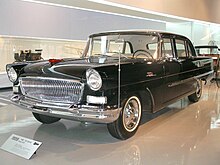History of China's Automotive Industry
This page provides information about the history of the automotive industry in China .
Period before economic reform (1949–1979)
Before 1949, there was no automotive industry in China . The demand for automobiles was satisfied by imports. The People's Republic of China has been ruled by the Communist Party since 1949 . The USSR supported the new Chinese government financially and technically in wide areas of industry. As an essential part of the industry, the auto industry was also part of this aid program.
In 1956 the China FAW Group ( FAW for short ) was established in Changchun in the Jilin Province , which initially only produced trucks with the designation “ Jiefang ” (German: Liberation) for China. Two years later, the first passenger car " Hongqi " (German: Red Flag) was manufactured by FAW, which had been specially designed for high-ranking officials in the Chinese government at the time. In 1958, Shanghai Automobile Assembly Plant produced a Phönix brand car , and in 1969 the Dongfeng trucks were mass-produced at Second Automotive Works , now known as Dongfeng Motor Corporation .
Period after economic reform (1979)
Since 1979, China's economic reform has brought many changes and opportunities for the whole industry. The domestic auto industry has developed rapidly since then. Today production is no longer carried out according to planned economy principles, but is increasingly oriented towards current market needs. In a first step, the Chinese central government eased the conditions for entering the automotive market. As a result, many new automobile manufacturers, such as Brilliance China Automotive Holdings , BYD Auto Corporation , Geely Auto Corporation and Chery Auto Corporation , were established in several provinces in China. In a further step, the central government drew up a so-called subsidy plan for the automotive industry in order to promote technological innovations and improve the product quality of domestically produced cars. As a result, foreign car companies are now also allowed to invest in China and establish so-called joint ventures with Chinese producers. One example of this is the successful cooperation between the German car group Volkswagen and FAW .
The Chinese auto market has been developing very quickly over the past 20 years. Today, demand is expected to grow by an average of 17 percent by 2010. With this sales boom, all the major automakers worldwide are pushing into China. The following table shows the major Chinese automakers and their global joint venture partners with their production sites.
| Automaker | Location |
| Beijing-Benz DaimlerChrysler Automotive | Beijing |
| Beijing Hyundai Motor Company | Beijing |
| BMW Brilliance Automotive | Shenyang (Liaoning Province) |
| Chang'an Ford | Nanjing (Jiangsu Province) |
| Chang'an Suzuki | Chongqing |
| Changhe Suzuki | Jingdezhen (Jiangxi Province) |
| Dongfeng Honda Automobile | Wuhan (Hubei Province) |
| Dongfeng Nissan diesel | Hangzhou (Zhejiang Province) |
| Dongfeng Peugeot Citroën Automobile | Wuhan (Hubei Province) |
| Dongfeng Yueda Kia Motors | Yancheng (Jiangsu Province) |
| FAW-Mazda | Changchun (Jilin Province) |
| FAW Toyota | Changchun (Jilin Province) |
| FAW-Volkswagen | Changchun (Jilin Province) |
| GAC Fiat Chrysler Automobiles | Changsha (Hunan Province) |
| GAC Toyota Motor | Guangzhou (Guangdong Province) |
| Guangqi Honda Automobile | Guangzhou (Guangdong Province) |
| Huatai-Hyundai | Yanbian (Jilin Province) |
| Nanjing Fiat Automobile | Nanjing (Jiangsu Province) |
| Nanjing Iveco | Nanjing (Jiangsu Province) |
| SAIC GM Wuling | Shanghai |
| Shanghai GM | Shanghai |
| Shanghai Volkswagen | Shanghai |
| Soueast | Minhou (Fujian Province) |
| Tianjin FAW Toyota Motor Company | Tianjing |
| Zhengzhou-Nissan | Zhengzhou (Henan Province) |
Car sales volume in 2009
According to data from the China Association of Automobile Manufacturers, 2.2 million automobiles were produced and sold by domestic automakers in 2009, representing 29.67% of China's total auto sales. Japanese, German, American, Korean, and French automobile groups produced and sold 1.85 million, 1.43 million, 0.97 million, 0.72 million and 0.27 million cars respectively last year, representing a market share of 24.85% , 19.25%, 13.01%, 9.6% and 3.62%.
| Ranking list | Automaker | Car model | Sales quantity in pieces | Selling price in yuan * |
| 1 | BYD | F3 | 193,100 | 59,800-99,800 |
| 2 | Beijing Hyundai Motor Company | Elantra -Yuedong | 180,400 | 99,800-120,800 |
| 3 | Shanghai GM | Excelle | 171,700 | 103,800-149,800 |
| 4th | FAW-Volkswagen | Jetta | 168,000 | 74,800-99,800 |
| 5 | Shanghai Volkswagen | Santana | 146,000 | 67,000-19,800 |
| 6th | Beijing Hyundai Motor Company | Elantra | 129,800 | 89,800-126,800 |
| 7th | Guangqi Honda Automobile | Accord | 125,700 | 181.800-339.800 |
| 8th | Chery Automobile | 121,200 | 30.800-50.280 | |
| 9 | FAW Toyota | Corolla | 113,700 | 127,800-172,800 |
| 10 | GAC Toyota Motor | Camry | 113,300 | 189,000-219. |
* The exchange rate between the euro and the yuan is approximately 1 euro = 8 yuan
See also
Individual evidence
- ↑ a b China’s Automobile Industry (PDF)
- ↑ China: New Car Industry Policy
- ^ Chinese Auto Manufacturers
- ↑ Globalization of the automobile industry in China ( Memento of the original from August 27, 2011 in the Internet Archive ) Info: The archive link was automatically inserted and not yet checked. Please check the original and archive link according to the instructions and then remove this notice. (PDF; 455 kB)
- ↑ Automotive market China 2010
- ↑ Car sales in 2009
- ↑ Top 10 sales winners in 2009 ( Memento of the original from April 14, 2010 in the Internet Archive ) Info: The archive link was inserted automatically and has not yet been checked. Please check the original and archive link according to the instructions and then remove this notice.

